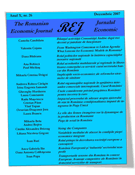Abstract:
Keeping in mind, India’s faster growth and trade integration in the world economy, this study attempts to examine the effects of bilateral trade between India and its 16 major trading partners from the developed and developing world, on business cycle co-movements through the channel of trade integration over the period 1980 to 2016. Detrended Real GDP has been used as business cycle indicator for all countries and the bilateral correlations are calculated to ascertain the association. The ABT measure of business cycle divergence is also computed to confirm the results. Two variants of trade intensity measure are constructed for studying the effects of bilateral trade on business cycle synchronization. The empirical evidence suggests that Indian business cycles exhibits significant co-movement with all the countries taken in the sample except for Iraq, as reflected by trend line parameters of rolling correlation coefficients. However, the trade linkage turned out to be significant with Australia, Iran, Japan, Great Britain, Saudi Arabia, Switzerland, Singapore, United Arab Emirates and United States of America for the time period under consideration. The slope coefficients of trade integration further reveal that trade between India and Australia, China, Iran, Saudi Arabia, Singapore and United States of America is of intra-industry type while that with Japan, Switzerland, Great Britain and United Arab Emirates, is of inter-industry type. Thus, in case of industry specific shocks, there will be business cycle synchronization in the intra-industry trading group but no synchronization in the inter-industry trading group. Hence, the relation between business cycle synchronization and trade integration for India, is found to be significant with Australia, China, Iran, Saudi Arabia, Singapore and United States of America out of the total sample taken.
